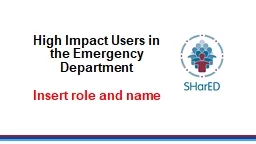

Insert role and name What are High Impact Users HIUs Patients whose use of the Emergency Department has a high impact either due to Having a high incidence of attendance 5 or more attendances per year ID: 917075
Download Presentation The PPT/PDF document "High Impact Users in the Emergency Depar..." is the property of its rightful owner. Permission is granted to download and print the materials on this web site for personal, non-commercial use only, and to display it on your personal computer provided you do not modify the materials and that you retain all copyright notices contained in the materials. By downloading content from our website, you accept the terms of this agreement.
Slide1
High Impact Users in the Emergency DepartmentInsert role and name
Slide2What are High Impact Users (HIUs)?
Patients whose use of the Emergency Department has a high impact, either due to:
Having a high incidence of attendance (5 or more attendances per year*)
Requiring a substantial amount of staff time and resources on more than one attendanceHaving a condition which is rare or unusualHaving a chronic illness requiring a high level of hospital attendances*The Royal College of Emergency Medicine, 2017
Slide3What are your thoughts and feelings around HIUs?
Slide4Why do patients become HIUs?
Patients often have chronic
mental health problems combined with social problems
(housing/homeless) and drug/alcohol patients. They can be vulnerable with chaotic lifestyles and may struggle to access other services. Frequent attenders to Emergency Departments also tend
to be frequent
users
of other health and social care
facilities.
A UK ED study showed that 65% had Mental Health symptoms, 15% had significant alcohol problems, and 45% had Medically Unexplained symptoms.(RCEM,2017)Frequent Attenders were found to have double the mortality of non-frequent attenders and causes of death include hypothermia and violent means of suicide
Slide5What is the aim of HIU team?
Reduce attendances
Improve patient experience
Improve outcomesProtect staffSave lives
Slide6The Core HIU Team
ED Consultant –
local name
ED Matrons – local name(s)High Impact User Co-ordinator (band 7 nurse) – local name(s)Business Intelligence Team for data extraction
Slide7The Wider MDT (
edit to local situation)
Outside of the acute trust
PoliceAmbulanceStreet/Control room triageMH trustOther acute trustsGPs
The Wider Multidisciplinary Team
Drug and Alcohol
Homeless Health
IDSVA
Liaison Psychiatry
Other CNS speciality teams, (e.g. Diabetes, Palliative care)
Safeguarding
MUPS (medically unexplained physical symptoms clinic)
Psychologist
Non-clinical admin and IT support
Slide8Support for the HIU team
Liaison Psychiatry
Emergency Department
Drug and Alcohol Teams
IDSVAS
Homeless Health Team
Charities
e.g.-
Samaritan
SWAST
Community e.g. GP
Police
Slide9How are patients identified?
Explain how patients are identified locally
Self referrals
Referrals fromEDReferrals from Liaison PsychiatryReferrals from GP/CMHTReferrals due to incident report
Slide10Process once patient is identified
(edit)
Triaged using Bristol EDITT (Emergency Department Impact Triage Tool) which aims to assess level of risk.Letter and questionnaire sent to the patient and their GP (and care coordinator as appropriate)Personal Support Plan (PSP) created using a multidisciplinary approach and discussion at the MDT (if appropriate), with as much patient input as possible. Copies
are sent to the
patient
and their
GP for
approval.HIU team will review the patient in ED if/when they attend, availability dependentPSP made available on patients electronic record with alert. Uploaded to Connecting Care (if applicable)Plans are reviewed yearly or as clinically indicated and archived if the patient has not attended in a year
Slide11Case Study –
an example, advised to insert local case study
HistoryAmy, aged 25. Attending 3-4 times a week with overdose. Seen by Liaison Psychiatry, under CMHT. Amy was not suicidal, she was compulsively taking overdoses due to OCD/Anxiety. Amy's anxiety was increased by staff repeatedly telling her how dangerous her behaviour was, and her feelings of failure when she had overdosed.
Management
A PSP was written, with Amy and her care
co-ordinator
. We asked staff not to start discussions with Amy about the dangers of overdosing, but to just answer any of her questions honestly. Amy was also working with CMHT, and as her attendances reduced ED staff offered positive observations about this, which helped Amy recognise the progress she was making.